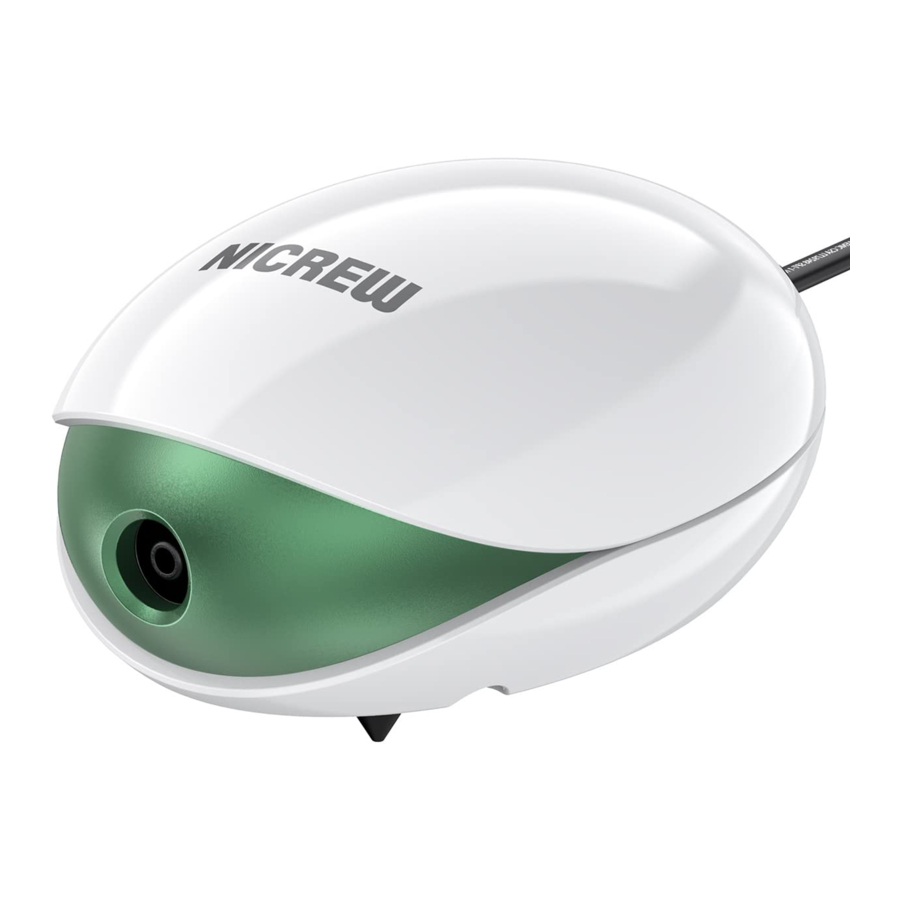
NICREW Aquarium Air Pump Manual
- Instruction manual (23 pages) ,
- Instruction manual (27 pages)
Advertisement

Installation
Installation 
Place the air pump on a shelf at least 30 cm (12") higher than the water level of the aquarium, but not directly above the aquarium.


Installation 
Place the air pump on a surface lower than the water level of the aquarium. To avoid damage from accidentally spilled water, do not place the air pump directly below the aquarium. Use a check-valve between the pump and the aquarium. It helps stop water from siphoning into your air pump in case of an electrical power failure or when removing filters from aquarium.

Installation 
Use the air pump with two ports for alternate installations.


Maintenance
- Airflow loss is usually caused by clogged airstones, which over me become blocked as algae, floating debris, and mineral deposits accumulate in the pores. If you notice a diminished air flow, try blowing through the airstone yourself. If this is difficult, replace the airstone.
- If you replace the airstone in your filter(s) regularly you do not have to be concerned about loss of air due to clogged airstones.
- Worn diaphragms or other rubber parts can also diminish air flow.
- Clean the outside of the pump with a damp cloth and mild detergent.
- Pump mechanism never needs oil.
Safety Instructions
- To avoid possible electrical shock, do not immerse pump in water. If pump falls into the water, or otherwise becomes wet, do not reach for it until you have first unplugged it.
- To prevent possible electrical shock resulting from water back siphoning, pump should be used with a check-valve or positioned higher than the water level.
- Carefully examine appliance air installation. It should not be plugged in if there is water on parts not intended to get wet.
- Do not operate appliance if it has a damaged cord or plug, or if it is malfunctioning, or if it is dropped or damaged in any manner.
- When removing filters, airstones or air-operated ornaments from aquarium, do not let water run into the pump. Leave pump running and prevent back-siphoning by removing the open end of the tubing from the pump nozzle and taping it to the top frame of the aquarium.
- Always unplug appliance from an outlet when not in use. Never yank cord to remove plug from outlet. Grasp plug and pull to disconnect.
- Do not install appliance where it will be exposed to weather, or to temperatures below freezing.
- Read and observe all important notices on the appliance and in the product literature.
- To avoid getting the appliance plug or receptacle wet, position the aquarium to the side of a wall-mounted outlet. Arrange a "drip loop" for each cord connecting an aquarium appliance to an outlet. The "drip loop" is the part of the cord below the level of the outlet that prevents water from traveling along the cord and coming in contact with the outlet. (If using an extension cord, the "drip loop" is located below the level of the connector.) If the plug or receptacle gets wet, don't unplug the cord. Disconnect the fuse or circuit breaker that supplies power to the appliance. Then unplug the appliance and examine the outlet for the presence.
![NICREW - Aquarium Air Pump - Drip loop Drip loop]()
Please contact us at support@nicrew.com.
For more informaon, please visit www.nicrew.com.
Documents / Resources
References
Download manual
Here you can download full pdf version of manual, it may contain additional safety instructions, warranty information, FCC rules, etc.
Advertisement









Need help?
Do you have a question about the Aquarium Air Pump and is the answer not in the manual?
Questions and answers